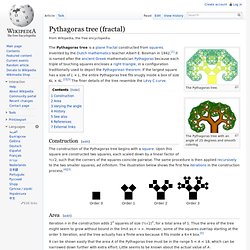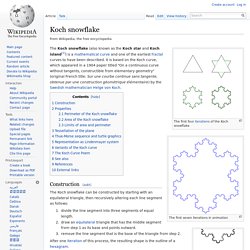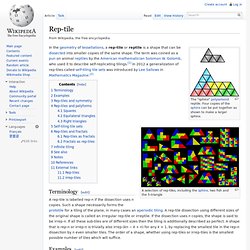

Stable Marriage Problem (the math bit) Infinity is bigger than you think - Numberphile. 3 is everywhere - Numberphile. Root 2 - Numberphile. Problems with Zero - Numberphile. Infinity Paradoxes (extra footage) How big is a billion? - Numberphile. Flaw in the Enigma Code - Numberphile. Enigma Extra Footage - Numberphile. Encryption and HUGE numbers - Numberphile. 31 and Mersenne Primes - Numberphile. Brown's Criterion - Numberphile. 1 and Prime Numbers - Numberphile. Primes are like Weeds (PNT) - Numberphile.
New Largest Known Prime Number - Numberphile. Proof Without Words: The Circle. Wau: The Most Amazing, Ancient, and Singular Number. A Song About A Circle Constant. Round Triangles! Pythagoras tree (fractal) The Pythagoras tree.

The Pythagoras tree with an angle of 25 degrees and smooth coloring. Iteration n in the construction adds 2n squares of size (½√2)n, for a total area of 1. Thus the area of the tree might seem to grow without bound in the limit as n → ∞. However, some of the squares overlap starting at the order 5 iteration, and the tree actually has a finite area because it fits inside a 6×4 box.[5] It can be shown easily that the area A of the Pythagoras tree must be in the range 5 < A < 18, which can be narrowed down further with extra effort.
An interesting set of variations can be constructed by maintaining an isosceles triangle but changing the base angle (90 degrees for the standard Pythagoras tree). In the limit where the half-angle is 90 degrees, there is obviously no overlap, and the total area is twice the area of the base square. Pythagoras tree was first constructed by Albert E. Lévy C curve. Koch snowflake. The first seven iterations in animation Zooming into the Koch curve The Koch snowflake (also known as the Koch star and Koch island[1]) is a mathematical curve and one of the earliest fractal curves to have been described.

It is based on the Koch curve, which appeared in a 1904 paper titled "On a continuous curve without tangents, constructible from elementary geometry" (original French title: Sur une courbe continue sans tangente, obtenue par une construction géométrique élémentaire) by the Swedish mathematician Helge von Koch. Construction[edit] The Koch snowflake can be constructed by starting with an equilateral triangle, then recursively altering each line segment as follows: divide the line segment into three segments of equal length.draw an equilateral triangle that has the middle segment from step 1 as its base and points outward.remove the line segment that is the base of the triangle from step 2. After one iteration of this process, the resulting shape is the outline of a hexagram.
Rep-tile. The "sphinx" polyiamond reptile.

Four copies of the sphinx can be put together as shown to make a larger sphinx. A selection of rep-tiles, including the sphinx, two fish and the 5-triangle Terminology[edit] Dragon curve. A dragon curve is any member of a family of self-similar fractal curves, which can be approximated by recursive methods such as Lindenmayer systems.

Heighway dragon[edit] Heighway dragon curve Construction[edit] It can be written as a Lindenmayer system with angle 90°initial string FXstring rewriting rules X ↦ X+YF+Y ↦ −FX−Y. That can be described this way : Starting from a base segment, replace each segment by 2 segments with a right angle and with a rotation of 45° alternatively to the right and to the left: The Heighway dragon is also the limit set of the following iterated function system in the complex plane: with the initial set of points Using pairs of real numbers instead, this is the same as the two functions consisting of [Un]Folding the Dragon[edit] Tracing an iteration of the Heighway dragon curve from one end to the other, one encounters a series of 90 degree turns, some to the right and some to the left. 1st iteration: R. Dragon Curve - Numberphile. Number 1 and Benford's Law - Numberphile. 1 and Prime Numbers - Numberphile.
4937775 - Numberphile. 15 and Hexadecimal - Numberphile. Why do YouTube views freeze at 301?